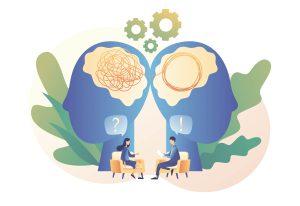
It’s convenient to think of learning as a standardized process that rarely changes. New information is presented, the mind absorbs and stores it, and that’s it. However, the problem with this heavily oversimplified perception of how we learn and retain things is the long list of unanswered questions.
Why do we choose to absorb some lessons and forget others? What factors improve or harm our ability to recall information when needed? What’s the best way to motivate retention?
As we dive deeper into the cracks within this overarching framework, we learn more effective ways to structure our environments, communicate, and interact with one another. This is why the great social science thinker and psychologist, Albert Bandura, dedicated much of his life’s work to formulating and testing his Social Learning Theory.

Who is Albert Bandura?
Who created the social learning theory? Albert Bandura is a renowned Canadian-born American psychologist who is most well-known for his social learning theory. His work in the field of psychology has focused on the areas of social cognitive theory, self-efficacy, moral disengagement, and self-regulation. He is most well-known for his Bobo doll experiments, which demonstrated how children learn through imitation and modeling. Bandura has received numerous awards and honors for his contributions to the field of psychology.
What Do Social Psychologists Do?
Social psychologists study how people think, feel, and behave in social contexts. They explore topics such as group behavior, social perception, leadership, nonverbal communication, conformity, aggression, and prejudice. They use a variety of methods to conduct research, including surveys, experiments, observations, and interviews. Their research helps to inform our understanding of how people interact with one another, and how to use this knowledge to improve our lives.

What Is Social Learning Theory
In a single sentence, Social Learning Theory is the imitation of observed learning in a social setting. First introduced by Bandura in 1963, Social Learning Theory sought to expand our understanding of learning and behavior through a new lens that captured the learning experience more comprehensively than the contemporary models of the day, including Cognitive Learning Theory and Behavioral Learning Theory.
Bandura believed that we absorb information by first observing the behavior of others in a social setting. After observation, we then decide to imitate the behavior, but only if we believe that this will produce a reward. Finally, a set of cognitive factors known as Bandura’s 4 principles of social learning will influence whether or not observed behavior is imitated. Let’s take a closer look at the definition of social learning theory and examine the components of observation and imitation, reward and cognition.
Social Observation and Imitation
Social observation and imitation: Children are an especially obvious case of the power of social observation, upon which SLT is built. We all have seen firsthand the propensity of children to imitate people around them, especially their parents and siblings. Bandura reinforced this with his landmark Bobo Doll Experiment, in which children placed into separate groups observed aggressive behavior.
In one group, the behavior being observed was rewarded. In the other group, it was punished. Bandura and company then encouraged the children to play with toys (a Bobo doll included), monitoring their responses. He was able to prove two things right away: First, children learn through observation and imitation. Secondly, the condition of the reinforcement (positive or negative) is a decisive factor in learning and imitation.

Expanding on Reinforcement
Expanding on reinforcement: Bandura believed the presiding theories on reinforcement (by the behavioral learning theorists) to be reliable, but incomplete. Like the behavioral learning theorists, he believed that punishment and reward either encouraged or discouraged behavior, but there was more to be explored. For example, other theories did not explain vicarious reinforcement, which refers to behavior learned from watching others receive punishment or reward from certain actions. This introduces a complicating level of subjectivity. One person’s reward, for example, is not necessarily another person’s reward, which will affect the likelihood of an observer to learn and imitate certain behaviors.
Cognitive Factors Affect Learning
Finally, Bandura emphasized that, even when all of the pieces are in place for an observer to learn and imitate a behavior (they observe the behavior and perceive that the reward is relevant to them), there are still several mediational processes that may stand in the way.
- Attention: The circumstances surrounding the observed event can affect our attention level, which in turn affects our ability to learn and imitate the behavior. For example, did the observer just catch a fleeting glance at the behavior in a crowded environment, or did they get a clearer view for several seconds?
- Retention: Even if the observer pays close attention to the behavior, if they are compromised in their ability to retain information, or if they don’t reproduce the behavior soon enough, it will be forgotten. The observer must form a vivid memory of the event and put it into practice to learn new behaviors.
- Ability to imitate: Even if the observer pays close attention and retains a vivid memory of the behavior, if they are unable to reproduce the behavior because of physical and/or cognitive limitations, then the prospect of the new behavior will be abandoned.
- Motivation level: The context in which the observer wishes to practice the new behavior can influence the strength of their incentive. If the possible reward is greater than the possible punishment, they will be motivated to practice the behavior. In high-risk scenarios, the observer is likely to reserve their attempt for a safer environment.
What are Bandura’s Four Principles of Social Learning?
It is these four ideas, referred to as Bandura’s 4 principles of social cognitive theory, that earned the model its place as the “bridge” between the behavioral and cognitive theories. As mentioned, behavioral theorists emphasize punishment and reward as the key drivers of learning. Our environment offers a stimulus, we respond, and the outcome determines whether or not we will repeat the behavior. Cognitive learning, on the other hand, places a much greater emphasis on the internal processing mechanisms that build our behavioral patterns.
While cognitive theorists acknowledge the role of the environment, they believe that a person’s unique internalization (past experiences, the way their brain stores information, how learners reflect on new information, etc.) of information is the largest player involved. These two schools of thought can be said to exist on either end of the “external vs internal” spectrum, and Social Learning Theory is situated in the middle. To better clarify the Social Learning definition, let’s provide some examples of the theory in action.

What are Some Examples of Social Learning Theory?
Social learning theory is an approach to learning that highlights the importance of observing and modeling the behavior of others. It is based on the idea that people can learn by observing what others do and say, rather than through direct instruction or punishment. Examples of social learning theory include imitation of others, observational learning, and vicarious reinforcement. For example, a child may learn how to ride a bike by watching a sibling or friend do it, or someone may learn how to dress by observing how others dress.
Media – Before there were social media “challenges,” people imitated famous actors from their favorite TV shows and movies. Dressing like James Dean, copying dance moves from popular music videos, and recreating famous action scenes are all fitting examples of Social Learning Theory. In most cases, this behavior is incentivized by the desire to become socially accepted, attractive, or otherwise well-liked.
Travelers and ex-pats – Everyone engages in social learning at some point or another, but travelers – especially those who intend to stay in a new area – must use social learning for adaptive purposes daily. When moving from the USA to Costa Rica, for example, observing and (accurately) imitating Costa Rican slang terms will help someone to assimilate faster.
New employees – Every workplace has its own subculture, some of which can differ greatly from the outside world. To remain in good standing, new employees can observe and imitate the practices of their peers. Always clocking in at least ten minutes early, for instance, may help the new employee to remain in the supervisor’s favor.
Children – By far the most evident examples of Social Learning Theory in everyday life are those demonstrated by children regularly. They imitate their siblings, friends, parents, and any famous figures whom they look up to. As long as the child perceives that their behavior will produce a relevant reward, they will likely imitate it at some point. This can include helping with housecleaning tasks, talking on the phone, and much more.
What is the Best Example of Social Learning?
There are many social learning examples. But, the best example of social learning is observational learning, which involves observing and imitating the behavior of others. This type of learning is especially common among children, who often learn through modeling the behaviors and attitudes of those around them. It can also be seen in adults, such as when a new employee learns how to do their job by observing their coworkers.

Social Learning Theory Summary
In summary, Social Learning Theory is a system of vicarious reinforcement in which someone observes and imitates a behavior in hopes of receiving a reward. For observed behavior to be properly imitated, Bandura’s 4 principles of social learning must be satisfied. First, the person must have paid close attention to the observed event and retained the memory for later use.
They must also find the proper social context in which to imitate the behavior, ensuring a reward will be produced (motivation). Finally, they need to be physically and/or cognitively capable of imitating the behavior. When all of these factors come together, a socially relevant path to learning is opened.
Bandura’s Social Learning Theory, proposed by psychologist Albert Bandura in 1977, is a cognitive-behavioral theory that explains how people learn new behaviors, beliefs and attitudes from observing, imitating and modeling others. This theory emphasizes the importance of observational learning, imitation, and modeling in the learning process. It suggests that human behavior is learned from the environment through the process of reinforcement, which affects the probability of a behavior occurring. This theory is one of the most influential of all cognitive learning theories and has been widely used to explain and predict human behavior, particularly in the areas of social psychology, clinical psychology, educational psychology and media violence.
Social learning theory examples can be seen in everyday life, from watching a child imitate a parent to a teen copying their peers’ fashion choices. In the learning process, social learning theory suggests that observation, imitation and modeling play a major role in how humans acquire knowledge, acquire new behaviors, form attitudes and develop social skills.
For example, a child may observe their parents’ behavior and imitate it in order to fit in with their family or their peers. A teen may watch their peers and imitate their fashion choices in order to look and feel cool. Social learning theory may also be used to explain aggressive behaviors, such as those found in media violence. In these cases, a person may observe a model engaging in an aggressive act and then imitate such behavior.
Social learning theory is not the only theory that can be used to explain human behavior. Other learning theories, such as behavioral theories, suggest that behavior is a result of environmental influences, rather than internal processes. Other theories, such as social psychology, suggest that behavior is a result of social interaction and environmental factors, such as family members and social workers.
What is the Main Idea of Social Learning Theory?
The main idea of social learning theory is that learning occurs by observing and imitating other people. The theory suggests that factors such as physical traits, emotional reactions and social environment can influence how a person learns and behaves. It also suggests that reinforcement, such as rewards or punishments, can affect the likelihood of a particular behaviour occurring.
In addition to this, the theory suggests that observing a positive role model can lead to desirable behaviors in an individual, while observing a negative role model can lead to negative behaviors. This is one of the most famous examples of social learning theory, as it is often used to explain why children imitate the behavior of their parents or family members.
Although social learning theory suggests that observing a role model is an essential factor in learning, it does not necessarily lead to desirable or negative behavior. Other factors, such as cognitive processes, environmental influences, and other learning theories must be taken into account in order to understand why a particular behavior occurs. For example, a healthy competition between peers can influence learning and lead to positive behaviors, while aggressive models can lead to aggressive behaviors.
Overall, Bandura’s Social Learning Theory is an important theory within the field of psychology that suggests that learning occurs by observing and imitating others. This theory suggests that many factors, such as reinforcement, role models, and cognitive processes, can influence the learning process and lead to both positive and negative behaviors. Furthermore, this theory has been widely used in clinical psychology, social psychology, media violence, and other fields to explain and predict human behavior.
Related:

